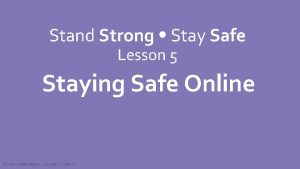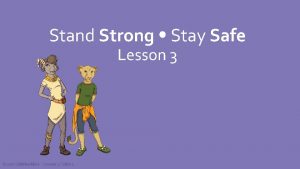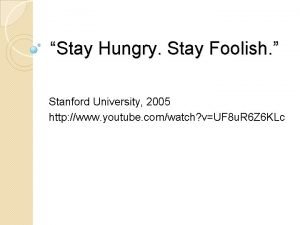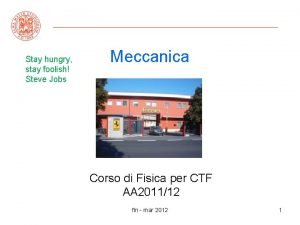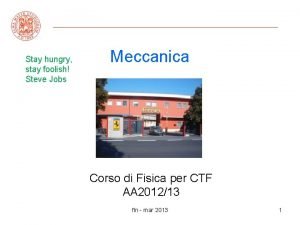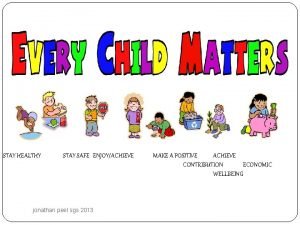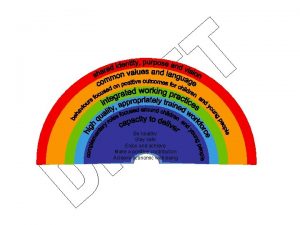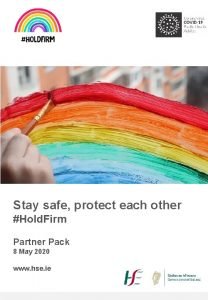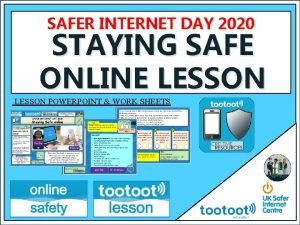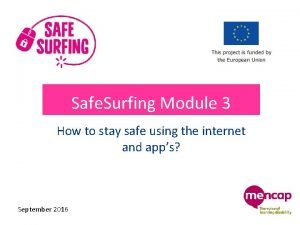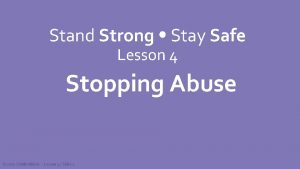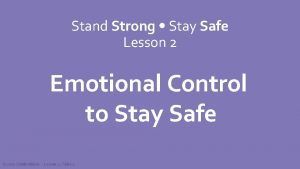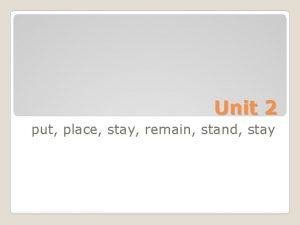Stand Strong Stay Safe Lesson 5 2017 Child


















- Slides: 18

Stand Strong Stay Safe Lesson 5 © 2017 Child. Builders - Lesson 5 / Slide 1

Click here to stream the video file. © 2017 Child. Builders - Lesson 5 / Slide 2

Definition of Abuse is when someone intentionally crosses your boundaries in order to hurt you. • Did Volt intentionally cross Twist’s boundaries? • Did Twist intentionally cross Volt’s boundaries? © 2017 Child. Builders - Lesson 5 / Slide 3

© 2017 Child. Builders - Lesson 5 / Slide 4

Volt’s Power to Choose © 2017 Child. Builders - Lesson 5 / Slide 5

Twist’s Power to Choose © 2017 Child. Builders - Lesson 5 / Slide 6

Emotional Control © 2017 Child. Builders - Lesson 5 / Slide 7

Where Are Emotions Felt? © 2014 National Academy of Sciences © 2017 Child. Builders - Lesson 5 / Slide 8

Emotional Abuse Emotional abuse is when a person intentionally crosses your emotional boundaries in order to hurt you. It is using words or actions to belittle, threaten, or make someone feel small, worthless, unimportant, or ashamed. © 2017 Child. Builders - Lesson 5 / Slide 9

Example 1 Sarah is worried about showing her dad her report card because he usually gets angry. She is proud of her work this time, but when she shows it to him he starts yelling, “I can’t believe you missed Honor Roll by one grade! You should have worked harder. How can I possibly be raising such a failure? If you don’t turn things around, say goodbye to your friends and electronics; I’ll make you shape up!” © 2017 Child. Builders - Lesson 5 / Slide 10

Example 2 For the third time this week, one of Rafaela’s classmates knocks her lunch onto the floor. Her grapes scatter everywhere and the kids at her table laugh as they stomp on them. Then they yell at Rafaela to eat the grapes off the floor. © 2017 Child. Builders - Lesson 5 / Slide 11

Bullying Characteristics • Anyone can be a perpetrator – both adults and children. • Bullying is intentional and hurtful. • Bullying usually occurs as a pattern of behavior over time, but can be a single significant hurtful event. • Bullying involves an imbalance of power; the perpetrator always has more power in the situation than the victim. © 2017 Child. Builders - Lesson 5 / Slide 12

Passive Bystanders © 2017 Child. Builders - Lesson 5 / Slide 13

Upstanders use their personal power to stand up against abuse and bullying so they can help keep their classrooms and communities safe. © 2017 Child. Builders - Lesson 5 / Slide 14

Emotional Safety Sheet 1. Read the scenario. 2. Identify the perpetrator, victim, and bystanders. 3. How could the characters make sure they were in control before reacting to the situation? 4. How could the victim respond in a way that keeps everyone physically and emotionally safe? 5. What could the bystanders do to help keep their community safe? 6. Is this response passive, aggressive, or assertive? © 2017 Child. Builders - Lesson 5 / Slide 15

Completed Emotional Safety Sheet 1. Read the scenario. 2. Identify the perpetrator, victim, and bystanders. 3. How could the characters make sure they were in control before reacting to the situation? 4. How could the victim respond in a way that keeps everyone physically and emotionally safe? 5. What could the bystanders do to help keep their community safe? 6. Is this response passive, aggressive, or assertive? © 2017 Child. Builders - Lesson 5 / Slide 16 Twist hurt Volt’s feelings intentionally because she felt hurt. Volt Jumps and Ray Stop, Breathe, and Think Twist could have said to Volt that she felt left out when he forgot to bring a snack she could eat, and they could plan to get something at her house later.

© 2017 Child. Builders

Stand Strong Promise I promise to Stand Strong and Stay Safe. I recognize that everyone has a right to be safe and respected, no matter who they are, what they look like, or what they believe. I will use my personal strength to be assertive and make responsible choices to help everyone in my community feel safe and respected © 2017 Child. Builders - Lesson 5 / Slide 18
 Stand strong stay safe
Stand strong stay safe Stand strong stay safe
Stand strong stay safe Good afternoon stay healthy
Good afternoon stay healthy Goodmorning stay safe
Goodmorning stay safe Be strong be strong be strong in the lord
Be strong be strong be strong in the lord Where you go i'll go where you stay i'll stay
Where you go i'll go where you stay i'll stay Stay tuned stay foolish
Stay tuned stay foolish Rascal flatts my wish for you
Rascal flatts my wish for you So stay so stay 再知己
So stay so stay 再知己 Summary of the daffodils
Summary of the daffodils Stay tuned stay foolish
Stay tuned stay foolish Stay hungry stay foolish significato
Stay hungry stay foolish significato Good afternoon and stay safe
Good afternoon and stay safe What condition threatens peeta’s life?
What condition threatens peeta’s life? Be healthy stay safe enjoy and achieve
Be healthy stay safe enjoy and achieve Be healthy stay safe enjoy and achieve
Be healthy stay safe enjoy and achieve Stay safe protect each other
Stay safe protect each other We're always being urged to stay safe online
We're always being urged to stay safe online Stay safe
Stay safe
